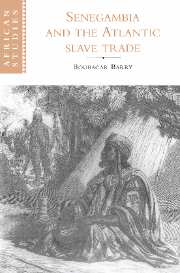Book contents
- Frontmatter
- Contents
- Preface
- Map
- I Senegambia from the fifteenth to the seventeenth century: a haven for incoming populations, a station for migrants on the move
- II Senegambia in the eighteenth century: the slave trade, ceddo regimes and Muslim revolutions
- III Senegambia in the first half of the nineteenth century: legitimate trade and sovereignty disputes
- IV Senegambia in the second half of the nineteenth century: colonial conquest and resistance movements
- 14 Colonial imperialism and European rivalries in Senegambia
- 15 Last-ditch resistance movements of legitimist rulers in northern Senegambia
- 16 The conquest of the Southern Rivers region
- 17 The balancing act of the Almamis of Timbo in their attempts to cope with centrifugal forces
- 18 Bokar Biro and the conquest of Futa Jallon
- 19 Mass resistance movements among the Joola and the Konyagi
- Conclusion
- Notes
- Bibliography
- Index
- Other books in the series
17 - The balancing act of the Almamis of Timbo in their attempts to cope with centrifugal forces
Published online by Cambridge University Press: 31 October 2009
- Frontmatter
- Contents
- Preface
- Map
- I Senegambia from the fifteenth to the seventeenth century: a haven for incoming populations, a station for migrants on the move
- II Senegambia in the eighteenth century: the slave trade, ceddo regimes and Muslim revolutions
- III Senegambia in the first half of the nineteenth century: legitimate trade and sovereignty disputes
- IV Senegambia in the second half of the nineteenth century: colonial conquest and resistance movements
- 14 Colonial imperialism and European rivalries in Senegambia
- 15 Last-ditch resistance movements of legitimist rulers in northern Senegambia
- 16 The conquest of the Southern Rivers region
- 17 The balancing act of the Almamis of Timbo in their attempts to cope with centrifugal forces
- 18 Bokar Biro and the conquest of Futa Jallon
- 19 Mass resistance movements among the Joola and the Konyagi
- Conclusion
- Notes
- Bibliography
- Index
- Other books in the series
Summary
Geographically, the Futa Jallon kingdom was situated in the West African hinterland, away from the main axis of French penetration in the Sudan and the Southern Rivers regions. For that reason, up until the 1890s it enjoyed a degree of autonomy which enabled it to play off one colonial power against the other. The game helped it to preserve its independence for quite a while.
Internally, the central regime, dominated alternately by Ibrahima Sori Dongolfella of the Soriya faction and Ibrahima Sori Daara and Amadu of the Alfaya faction, went through a period of real calm because both sides were scrupulous in the observance of the principle of alternating terms. The kingdom therefore functioned normally from 1872 to 1890. The resulting stability put the Almamis in a position to cope with a revival of centrifugal forces, namely the continuing agitation of the Hubbu movement and the determination of the provincial chiefs in Labé and Timbi to assert their autonomy. In 1883, the Almamis asked Samori to help them crush the Hubbu movement by attacking the fortified village of Boketto. Survivors of the movement fled to Ndama and Gomba, where they reinforced new centers of resistance. For nearly forty years the Almamis had humored the powerful Alfa of Labé, Ibrahima, in his desire for independence. But after he died in 1881, his prospective heirs plunged into a fratricidal succession war.
- Type
- Chapter
- Information
- Senegambia and the Atlantic Slave Trade , pp. 263 - 283Publisher: Cambridge University PressPrint publication year: 1997

